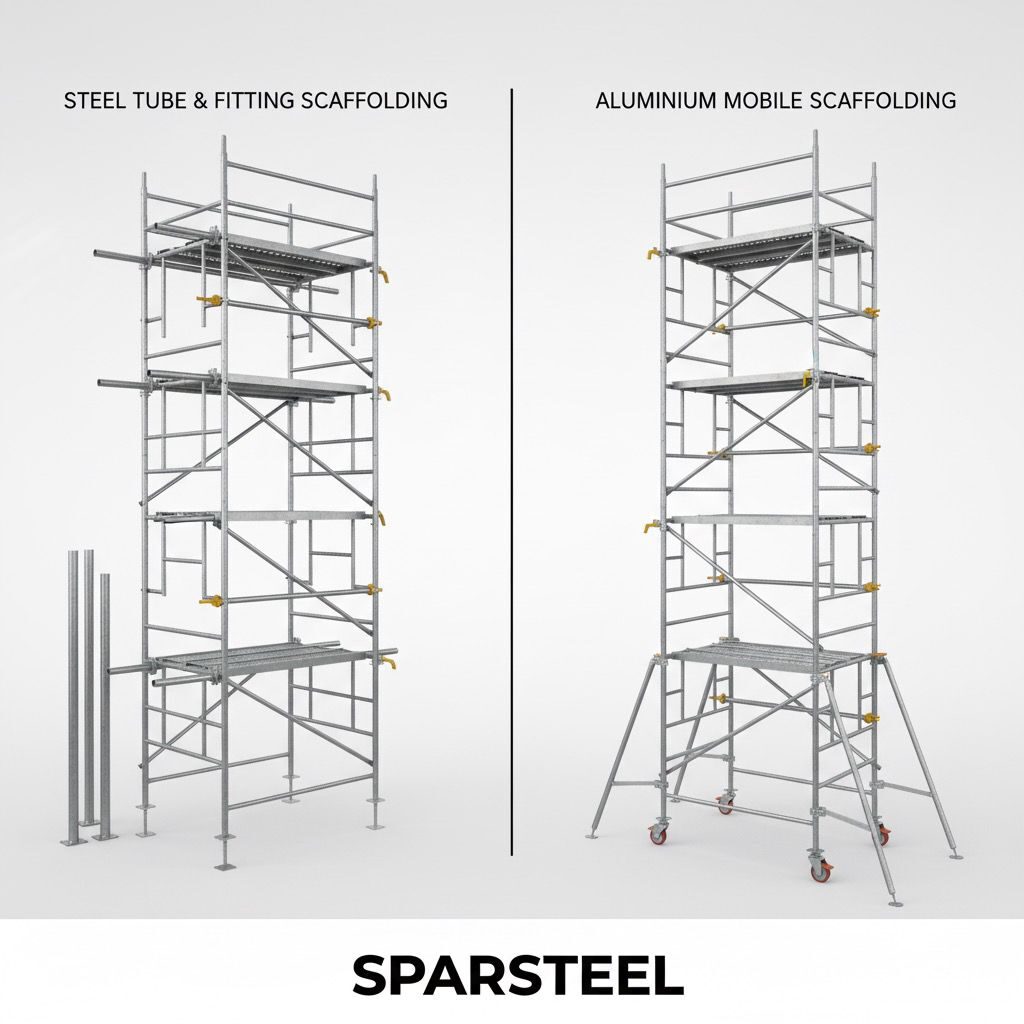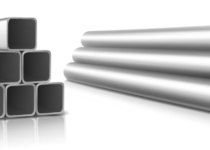Steel Tube Scaffolding vs Aluminum

In the demanding Gulf construction market, scaffolding is more than just access support; rather, it is a critical engineering system that must withstand extreme weather, long-term exposure, and substantial industrial loads.
As a result, the Gulf Cooperation Council (GCC) region presents one of the harshest material environments globally. Specifically, summer temperatures regularly exceed 50 °C, coastal humidity often reaches 90%, and in addition, there is a pervasive combination of dust, salt, and high winds.
Material Composition & Structural Strength of Steel Scaffolding vs Aluminum
Steel Tube Systems
SPAR Steel is a trusted producer of Electric Resistance Welded (ERW) tubes, which are manufactured from top-quality hot-rolled coils and comply with the stringent BS 1139 and EN 10219 standards.
Consequently, these premium tubes form the foundational material for our robust range of scaffolding systems, including Cuplock, tube and fittings, and shoring systems.
which are the most used in oil, gas, and infrastructure projects.
- Material Grade: S355 / ASTM A500
- Size Range: 48.3 mm OD × 3.2 mm wall thickness (standard scaffolding)
- Yield Strength: ≥ 350 MPa
- Compressive Load Capacity: Up to 40 kN per leg
Aluminium Systems
Aluminium scaffolding employs alloy grades such as 6061-T6 or 6082-T6. These alloys are light in weight and resistant to corrosion, but have lower yield strength than structural-grade steel.
- Material Grade: Aluminium Alloy 6061-T6 / 6082-T6
- Yield Strength: 250–275 MPa
- Compressive Load Capacity: Usually ≤ 20 kN per leg
Verdict:
The compressive power of steel tubes is almost 1.5× that of aluminium is the reason why they are the most appropriate for heavy-duty applications the likes as refinery shutdowns, high-rise construction, and shoring platforms. Aluminium is good for temporary access work, maintenance, and light façade projects.
Durability and Corrosion Resistance in GCC Conditions: Steel Scaffolding vs Aluminum
The environment in the GCC is very harsh due to, among others, the constant exposure to UV rays, the air full of salt, and the thermal cycle between day and night.
Aluminium
- Corrosion-resistant in nature, resulting from an oxide layer that forms on its own.
- Nonetheless, in coastal areas rich in chlorides, such as Jebel Ali, Jubail, and Dammam, pitting and galvanic corrosion may take place, most notably when aluminium is in contact with steel or copper.
- The surface is very soft and can be scratched even when the material is being handled, thus corrosion pits will form.
- In order to have a longer life, it should be examined periodically and re-anodized if necessary.
Steel
- On being hot-dip galvanized according to ASTM A123, the steel tubes of SPAR achieve a zinc coating thickness of 85–100 µm, thus assuring corrosion protection for a long time even under extreme humidity and salt exposure.
- Steel creates a uniform barrier; removed or damaged parts can be repaired by using zinc-rich primers without the structure being weakened.
- Besides that, steel keeps its dimensions constant – it does not bend or warp due to thermal expansion as much as aluminum, which almost doubles its expansion rate in the heat of the GCC.
In long-term projects, the galvanized steel is observed to be outperforming aluminium by providing stable performance, simpler surface repairing, as well as better load retention. This is especially true for hot, saline, and abrasive conditions found in the Gulf.
Cost Lifecycle and Return on Investment
The very first purchase price only reveals a part of the entire tale. The total lifecycle cost of buying, upkeep, fixing, and reselling is what really determines the value of a thing over time.
| Parameter | Steel Tube Scaffolding | Aluminium Scaffolding |
| Initial Cost | Not too expensive (AED 8–12/kg) | Expensive (AED 18–24/kg) |
| Load Capacity | Heavy-duty | Medium-duty |
| Maintenance | Minimal (repair of galvanized coating) | From medium to high (re-anodizing and inspection needed) |
| Average Service Life | 10-15 years (if regularly checked) | 5-7 years in outdoor conditions typical of the GCC |
| Reusability | 2000+ uses | 1000-1200 uses |
| Resale Value | Good because of metal recovery and long life | Lower because of deformation and oxidation |
Verdict:
Although aluminium helps to lessen the weight, it seldom keeps up with the long-term reuse cycles that are typical of Gulf contractors.
The ERW galvanized steel tubes of SPAR provide a lower total cost of ownership, extended service life, as well as higher residual value very important to companies working with rental fleets or those that supply large EPC contractors.
Safety is always the main parameter for any scaffold system. The Gulf multi-level industrial projects, e.g., offshore rigs of ADNOC and petrochemical plants of SABIC, need scaffolds that support heavy loads as well as withstand wind pressures and structural vibrations.
- The steel tubular structure is a rigid frame that keeps the loaded parts from flexing.
- The increased density contributes to less wind-initiated shaking.
- They are compatible with Cuplock, Kwikstage, and Tube & Fittings setups.
- Enables increased bay heights and platform loads.
- Conforming to ARAMCO GI 8.001, ADNOC HSE CoP 06, and SABIC SES-A-104 scaffold safety standards.
Aluminum Systems
- Lightweight, but stability is compromised in the presence of strong winds or heavy loads.
- Tall structures additionally require bracing that absorbs more assembly time.
- The surfaces of the coupler joints are subjected to wear in the case of repetition, thus facilitating the mechanism of the aluminum installation.
Verdict:
Steel systems are the ones that provide the highest safety margins and the least deflection under load for projects on the scale of the GCC, such as high-rise structures, refineries, shutdown operations — a very important factor for contract compliance with ADNOC, SABIC, and ARAMCO.
Performance Under Heat and Humidity
Thermal Expansion
- Aluminium expands almost twice as much as steel with every 10°C increase in temperature.
- At sites in the UAE where temperatures vary from 25°C to 55°C, aluminium scaffold alignment is often changed to ensure that the frame is stable.
- The lesser coefficient of thermal expansion of steel keeps the geometry as well as the alignment very stable through different shifts.
Humidity and Salt Exposure
- The galvanized finish on SPAR’s steel tubes provides a zinc layer that is not only protective but also self-healing in case of scratches.
- The oxide layer of aluminium is thinner and, under the salt exposure, may get microscopic fissures.
- The aluminium joints are also getting damaged at an accelerated rate if condensation keeps forming and dust is accumulating.
Verdict:
Steel keeps its strength and alignment during temperature variations, whereas aluminium will have to be checked more frequently and repositioned during long-term GCC projects.
Logistics and Regional Supply Advantage
SPAR Steel Industries operates one of the most technologically advanced Electric Resistance Welded (ERW) tube production plants in the UAE; consequently, establishing itself as the main provider of scaffolding tubes, Cuplock systems, and fittings across the entire GCC region.
SPAR Manufacturing Strength
The company’s capability is robust, as evidenced by its Tube Mill Capacity of 60,000 MT annually (ranging from 1.2″ to 6″ diameter). Furthermore, all products strictly adhere to international standards, specifically BS 1139, EN 10219, and ASTM A500. Notably, all key Production Lines—Slitting, forming, welding, and galvanizing—are managed entirely in one integrated facility.
In terms of Quality Assurance (QA/QC), SPAR maintains rigorous testing, including verification of tensile, flattening, drift expansion, and bending properties, as well as precise confirmation of coating thickness and adhesion. Moreover, inspections are routinely conducted by reputable third parties, such as TÜV, BV, and Intertek. Finally, complete traceability is ensured: the mill certificate is engraved on each tube with the identification code “SPAR STEEL – UAE – HEAT No.” to guarantee accountability. Due to this comprehensive strength, SPAR maintains a high Inventory Readiness, keeping over 2000 tons of scaffold tubes, couplers, ledgers, and transoms readily available in the stockyards of the UAE.
Regional Advantage
- Production that takes place locally gets rid of the waiting time for shipments from foreign suppliers.
- Large-scale tender proposals for ADNOC, ARAMCO, and EPC can be responded to much quickly.
- Shorter routes for the delivery of goods, as well as customs formalities, are the advantages of Saudi Arabia, the UAE, and Oman.
- Local technical support and load calculation assistance are available.
Verdict: SPAR can deliver stock that is ready for use and comes with mill certification and ADNOC/ARAMCO compliance in a matter of days, a great advantage in the time-sensitive project environment of the Gulf region, whereas international suppliers usually face 8 to 12 week shipping cycles.
Environmental & Sustainability Factors
The aluminium material is generally advertised as a “green” one due to the fact that it is recyclable; however, the energy-intensive aluminium smelting leads to its carbon emissions being higher than steel per metric ton.
SPAR’s ERW steel fabrication is accomplished with low emissions in mind, and it achieves this by:
- Energy-efficient induction welding lines
- Closed-loop cooling systems
- Scrap recovery for reprocessing
- Coils are sourced locally, thus carbon emissions related to transport are minimized
Material turnover and waste are significantly reduced when comparing steel systems to aluminium because steel lasts significantly longer, i.e., it does not need changing as often.
Case Comparison of Steel Tube Scaffolding vs Aluminum: GCC Industrial Scaffold Deployment
| Parameter | Steel Tube Scaffold (SPAR Cuplock) | Aluminium Scaffold Tower |
| Primary Use | Heavy-duty industrial, oil & gas, infrastructure | Light access, maintenance, and MEP work |
| Max Platform Height | Multi-bay towers: more than 60 m | Mobile towers: up to 12 m |
| Load per Bay | 6.25–8.0 kN | 2.0–3.0 kN |
| Weather Resistance | Very good (due to the galvanized coating) | Conditioned moderately (needs regular inspection) |
| Weather Resistance | High (galvanized coating) | Moderate (requires inspection) |
| Project Examples | ADNOC refinery scaffolds, ARAMCO shutdowns, port expansion, high-rise core access | Facility maintenance, painting, and HVAC servicing |
| Expected Life | 10 to 15 years | 5 to 7 years |
| Availability in the UAE | Manufacturing that is done locally, plus stocked by SPAR | Imported, limited distributors |
SPAR Steel Advantage
SPAR Steel is the most reliable scaffolding partner for contractors in the GCC region.
Why Choose SPAR Steel Systems
- In-house ERW Tube Manufacturing: Absolute control of quality and details.
- Complete Cuplock System Supply: Standards, ledgers, transoms, braces, and couplers.
- ADNOC, SABIC, and ARAMCO Compliance: Documentation, test certificates, and QA traceability.
- Local Engineering Support: On-site scaffold layout and tie-in design advisory.
- Fast Delivery: Stockyards in the UAE with dispatch 24 hours for urgent site mobilization.
- Long-Term ROI: A service life of more than 10 years under Gulf conditions has been proven.
Conclusion
Aluminium scaffolding is good and easy to use in a controlled indoor environment. However, for the scale, load, and climate realities of the GCC, steel tube systems are safer, stronger, and more cost-efficient.
SPAR Steel’s ERW tube manufacturing, galvanizing expertise, and local UAE supply chain are the main reasons why each copper, tubing, & Fittings scaffold meets world standards while remaining reliable under heat, humidity, and time pressure in the Gulf. Contractors, EPC firms, and industrial operators are faced with a straightforward decision:
One firm commitment, safe construction, and dependability on SPAR Steel engineered for the Gulf.
For more details, visit sparsteel.com


